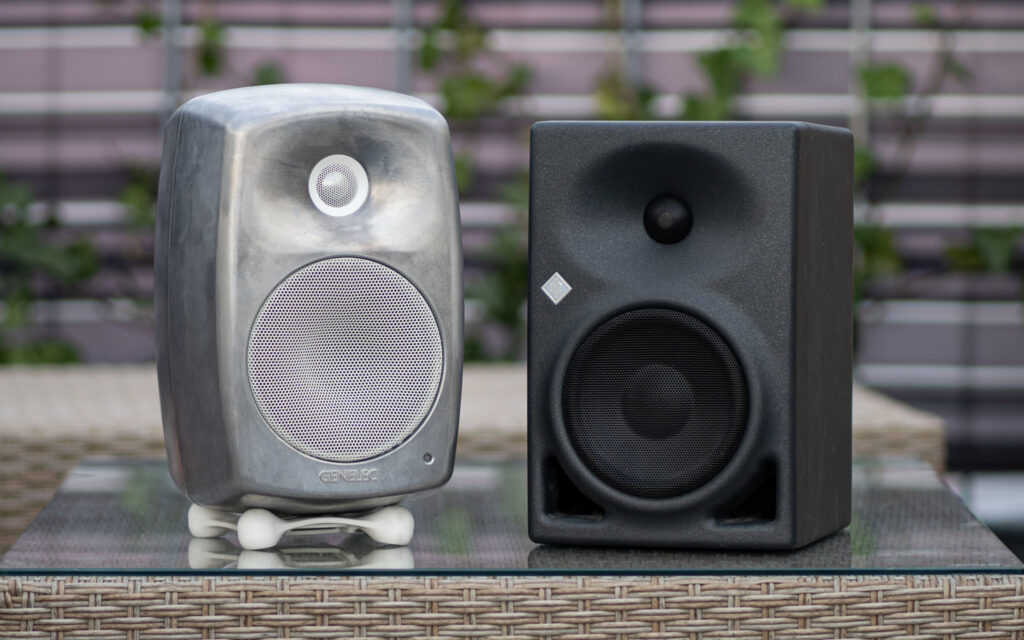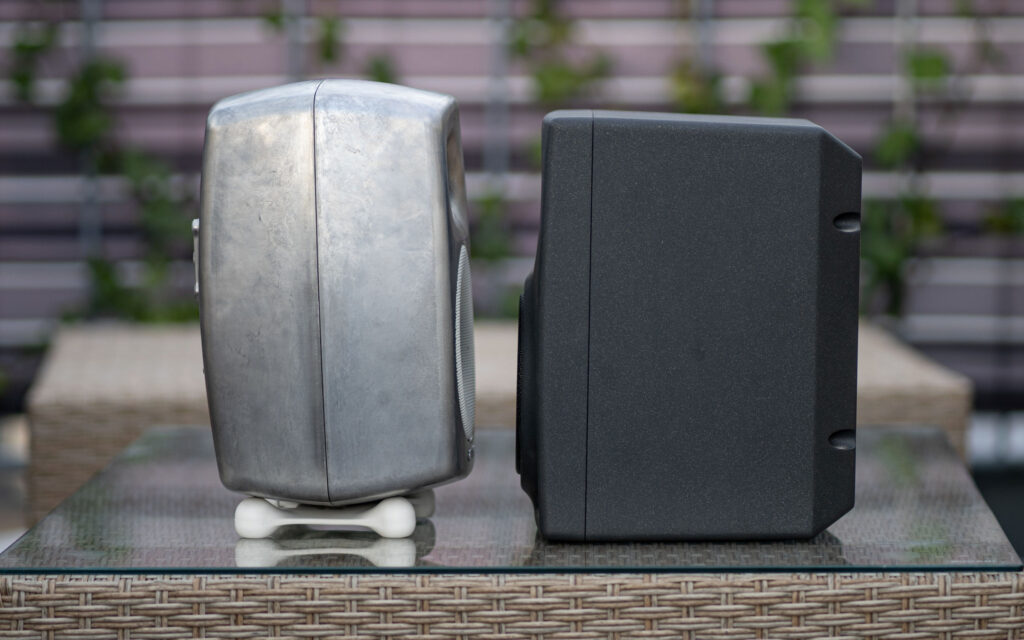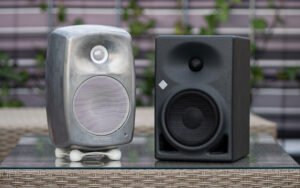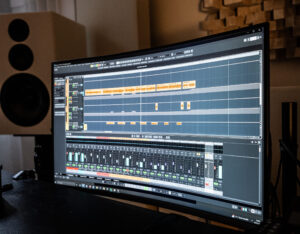Genelec has been a major name for studio monitors for decades, the Finnish manufacturer’s success story started in the late 70ies and their speakers became sought-after almost instantly. By the late 80ies Genelec was a household name in the pro-sound business and in 1991 they released their most iconic speaker yet, the legendary 1031a. The 1031a became a studio-standard, found all around the world and often attempted to be replicated. Many years later Genelec is still at the forefront of innovation with an impressive lineup of studio monitors both small and big. The “The Ones” Series with their coaxial driver design have a reputation for being some of the most-detailed and balanced speakers out there, and also Genelecs in-house room-correction system SAM, that works together with SAM monitors to adapt to the listening environment they are used in, has recieved amazing reviews all over the board.
This week I had the opportunity to try out the Genelec 8330’s with the SAM room correction system in my own studio, and hear what the signature Genelec sound feels like. Of course it was the perfect opportunity to compare them to my regular monitors of choice, the Neumann KH120, and also answer a few other questions about the system.

Unpacking
The 8330 Test Kit comes in a roadcase and includes the GLM System and cabling. The “raw” finish is the most recent color way for Genelec monitors, they are cast aluminium and left unpainted, letting the rough finish of the silver metal shine. While the raw finish monitors usually come with black protection grids and stands, the speakers in the test kit come with white ones, which is a bit of a weird match. Regardless, they stand out in comparison to most black or grey speakers, and could look really cool in the right setup.
The speakers have a small footprint due to their round edges and are also relatively light. I don’t think much smaller 5 inch monitors would make sense, except for maybe coaxials. The bass reflex ports are at the back, which could be a disantvantage in some tight settings but turned out to be just fine in mine. Since the speakers are meant to be used with the GLM Kit, they have no switches for roll-offs, room compensation or even level on the back. They have an analog and a digital Input, as well as ethernet inputs to connect them to the GLM system.
Setup and Calibration
Installing and calibrating the GLM system was super easy and pretty much self-explanatory. Once you’ve downloaded and installed the GLM software, you connect the speakers to the GLM system and the system itself to your computer via USB. Immediately you will see the connected speakers pop up on the screen, where you will tell the software which speaker is which (left & right, or in case of a surround system, front & back etc.). Next up you will enter the dimensions of your room, a name for the speaker group that will store your calibration settings and you’re ready to go. The mic has to be set up in front of the speakers in your listening position and the system does the rest by itself. Each speaker will play a frequency sweep sound and record the frequency response. The sweep sound is stored on the speaker itself and not effected by your analog input or volume settings.
The resulting measurement curve of the room is compensated inside the speakers, using up to 16 notch and 4 shelf filters, offering a pretty intricate correction of room resonances. GLM4 will not only cut spikes, but also slightly attemt to fill valleys by boosting frequencies. The boosts are rather subtle and using a wider Q, which makes sense for two reasons, firstly because boosting frequencies using EQ curves will reduce the avaliable headroom of the speaker, secondly dips in the response that are caused by room interferences cannot be remedied by boosting those frequencies. Once you’re happy with the sound you can store the DSP settings on the speakers themselves so you don’t have to keep the GLM system connected. Funny enough when it is connected, the speakers only work once you open the app. Disconnect the system and they work as regular monitors with the room compensation and level settings saved.
First Impressions
Straight out the box the Genelecs sound full, linear and unhyped in the high end and a little boomy, which has to do with the fact that I’ve set them up on a desk without being able to dim any of the low-mids and bass frequencies right away. Once I’ve set up the GLM Kit the measurement revealed a nasty spike at around 60Hz and a couple smaller ones up to 300Hz. The boominess is removed instantly and reveals a very linear sounding low-end response, while still sounding more on the full and warm side in the low-mids. The low end is generally impressive for the cabinet size, they deliver a full sounding bass and extend down to around 50Hz. The high end sounds smooth and very controlled, not harsh or sibilant at all. The stereo field is wide and precise which might also be due to the round shape of the speakers.
I was interested in trying to mimic the filter response of the measurement using the internal EQ of my Converter (ADI2 PRO Black Edition) and seeing how it stacks up to the internal adjustments made in the speakers. After using the results of the GLM measurement and carefully reproducing the curve with the RME’s EQ, I got pretty close with still some minor differences. I realized that turning on the calibration in GLM seems to make the playback ever so slightly louder. It sounds like there is a slight compensation for the reduced bass frequencies and therefore higher headroom happening. The upper mid to high freqiencies stand out a little bit more after turning the compensation on, even though the GLM filter response shows a smooth rolloff of 1dB starting at 500Hz. When A/B-ing the calibration on and off, the impression I get is somehow contrary to the high-freq rolloff that the filter is showing, but it might just be due to some level-matching going on after GLM applies the cuts. However, after a couple hours of tweaking and back and forth listening, I created an EQ curve in my converter that sounds very similar to the GLM room correction, using only dips where the low frequency buildup happens. The GLM correction still sounds a little bit tighter, but the difference was subtle to say the least. In a way my copied curve in the RME’s DSP sounds even a tad more natural to me.
What would happen now, if I applied the same EQ curve to the Neumanns, basically copying the GLM room correction to the KH120? Let’s find out.
Comparison to Neumann KH120A
Changing the monitors back to my old Neumanns, I think that they sound somewhat similar overall – Sure they are different, but there are other monitors out there that sound vastly different, like my Yahama HS80, while the Neumanns and Genelecs are kind of in the same ballpark of sound, very clean and linear. My model of the Neumanns doesn’t come with an integrated room correction system, while newer DSP versions do. Turning on the EQ in my interface reveals similar improvements as in the Genelecs, the boomyness in the low-mids and bass is reduced, some frequencies that used to sound exaggerated now sound more linear. It is definitely an overall stronger improvement in sound than using the bass and low-mid attentuation switches on the back of the speakers, because these attentuations are not at all calibrated to your room and just offer a wider more general correction.
This tells us that any system of calibrated measurement and corrective EQ can improve the linearity of your speakers, although there are different ways of implementing it. The GLM system works very well and has been refined and improved over years, but I think it’s fair to say that similar results are achievable with a quality measurement microphone and a parametric EQ, wether software or DSP.
The following paragraph covers my subjective impression of the speakers and as always, that is a matter of taste and preference. Some people might disagree with my assessment, but I am trying to describe the sound I’m hearing to the best of my knowledge and ability so you can get a better picture of it.
Generally the Genelecs sound more mid-forward and focused than the Neumanns. Midrange information like vocals seems more present, the whole soundstage sounds glued together and uniform. The Neumanns on the other hand sound overall bigger to me, more differentiated and uncompressed. The mids are represented in a layed-back way, not as present as the Genelecs but more lush, however not muddy or undefined at all.
Turning the GLM correction on makes the sound of the 8330 come together in a uniform way but there is also a hint of a somewhat processed soundig midrange. It’s very subtle and doesn’t alway show, so it’s hard to put my finger on.
For bass response I would give the clear win to the Neumanns, they sound deeper and the bass is more defined and effortless. Even when using a subwoofer on both speakers the Neumanns seem to reach lower and sound overall more linear to me. The bass I’m hearing is punchy and round. The Genelecs sound tighter in the bass but also not as smooth, somehow more like you would expect smaller speakers to sound. Both are very detailed but again the Neumanns ability to play very uncompressed makes them seem a bit more detailed and accurate overall. The Genelecs on the other hand excell in playing music less differentiated but therefore more uniform and exposing how well it all fits together.
I am generally a bit wary of digital monitors, simply because I feel like no matter how good converter chips have become over the years, it seems weird to me using a high-end converter like the ADI-2 PRO or others in that price range, just to have the signal converted back and forth inside the speakers anyways.
I remember many years ago when I bought the KH120s, I listened to a variety of speakers directly in the store. I compared them to a set of APS Trinity, a 10 inch three-way monitor costing around €5000 a piece. The way these monitors resolved the entire spectrum of music, creating almost like a wall of sound where each and every element of the mix could be pin-pointed with insane accuracy, was impressive to say the least. The clarity and differentiation of all elements in the music was exactly what you would want to make informed mixing-decisions while at the same time being very enjoyable to listen to. Having heard the sound of the APS speakers I compared a bunch of smaller and more affordable models to what I just heard. The Neumanns gave me the most of that experience. They were similar in the way they deconstructed the music into all of its elements, effortlessly showing what is going on without muddying or masking any aspects of the sound. Today, many years later, comparing the Neumanns to the Genelec 8330 confirms what I remember from testing back then. The KH120 excel by sounding uncompressed and natural, maybe not as “exciting” as some other brands, but absolutely accurate and detailed.
Spec Comparison

Genelec 8330
Dimensions (w*h*d): 189mm x 299mm x 178mm
Weight: 5,5 kg
Tweeter: 0,75″
Woofer: 5,1″
Amps: 50W + 50W RMS Class D
Frequency-Response (audible): 50 Hz – 20kHz
Cabinet: Bass reflex, back ported, Aluminium
Price 2022: €745/piece
Neumann KH120a
Dimensions (w*h*d): 182mm x 277mm x 220mm
Weight: 6,2 kg
Tweeter: 1″
Woofer: 5,25″
Amps: 50W + 50W RMS Class AB
Frequency-Response (audible): 45 Hz – 20kHz
Cabinet: Bass reflex, front ported, Aluminium
Price 2022: €660/piece, €1.099 for the digital version
Price, Avaliability & Bottom Line
At the time of writing the 8330s have been out for over a year now and are priced at around €750 per single unit. The SAM room correction system will cost you an additional €300 and is a no-brainer, except if you are already using another calibration system. Still it would make sense to go with the in-house solution that uses the built-in functionality of the speakers.
The Neumanns on the other hand have been around since 2011, and are based on the Klein + Hummel O110 which has been around even longer. Today they are more affordable at €660 per speaker, and even though they don’t offer digital connectivity or built-in room correction, they still outperform the Genelecs in terms of sound overall. The digital version, the KH120D however, is much more expensive and still doesn’t have a DSP onboard like its smaller sibling the KH80. If you are looking for a digital speaker the Genelecs offer a lot more functionality for the price and might beat the Neumanns in that regard.


